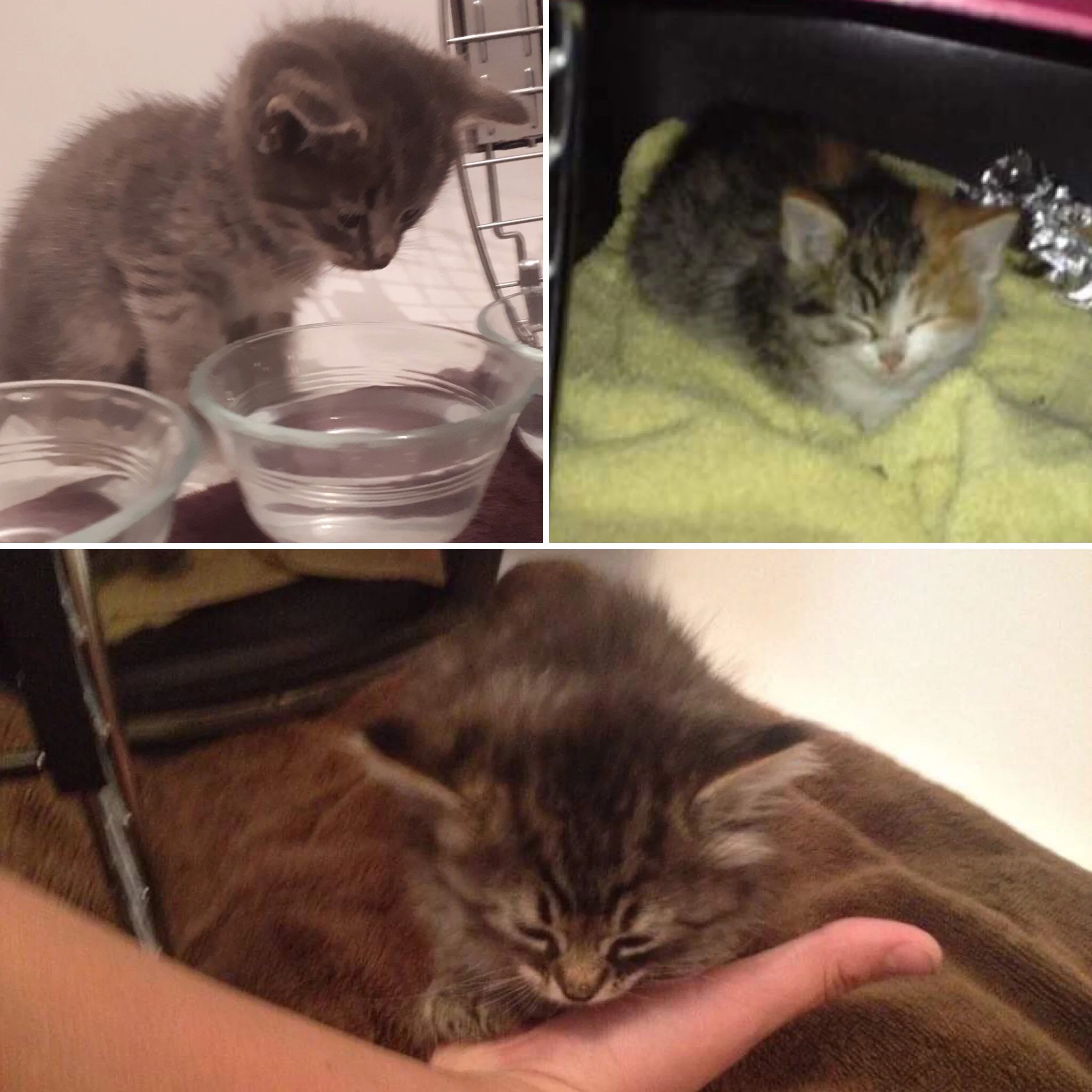Upper left, Trooper; upper right, Pixie; bottom, Jellybean
A little while ago, a friend of Cat Mom Calgary wrote to me late at night: they had found three abandoned kittens outside who were too young to have been weaned; what did they need to do to look after the kittens? My friend wanted to foster the kittens. (I have my friend’s permission to share this story and photos.)
If they had been unable to look after the kittens beyond the night, I would have recommended my friend take the kittens to Meow Foundation, AARCS, or Calgary Humane Society in the morning.
Assessing Health: do the kittens need immediate medical care?
From the photos, I guessed Trooper, Pixie, and Jellybean were between three to four weeks old; they didn’t appear injured or ill. So there was no immediate concern that required a visit to a 24-hour pet hospital. I did advise my friend to take the kittens to the vet as soon as possible, which they did. Fortunately, all three kittens were given a clean bill of health.
Safe Environment: kitten proof with adequate and appropriate resources
When you find kittens late at night and nothing is open for you to get the optimal kitten supplies, you have to make do with what you have access to.
My friend has an adult cat named Peach and used Peach’s supplies to make do for the kittens overnight. In the morning, my friend got kitten food appropriate for kittens who are weaning—I liked Royal Canin for Tom—and a kitten-specific litter. (I used Naturally Fresh’s Kitten Natural Training for Tom and use the adult cat version now that he’s grown.) Whatever litter you pick, you want one that is nontoxic, so I would recommend against clay or silica litters. Like human babies, part of how kittens explore the world is through their mouths, so a curious kitten might nibble on litter before realizing litter isn’t food.
Some kittens, like Pixie, will need to be fed milk through an eye dropper and have their food mixed with the milk. Your vet can best advise you on what your kitten needs to thrive.
This was how my friend set up the environment in the bathtub upon bringing the kittens home:
Temporary home for the kittens my friend made late at night after bringing the kittens in.
Some of Peach’s food, with added water, was put in each of the dishes. Three water dishes were put to the other side. Cats often don’t like having food and water beside each other for cross-contamination worries.
We weren’t going to make the kittens share food and water, which is why there are three bowls of each. Having one litter tray at this stage works for littermates. Notice the litter tray is farther away from the other resources. The litter tray needs to be close enough to the nest for the kittens to use but not so close that the kittens might worry it’ll contaminate the resources in the nest. Cats have an instinct to keep their nest clean.
The carrier had towels in it, and the bathtub was lined with a towel. We wanted the kittens to be cozy and not cold, so soft, warm, dry surfaces were important.
Litter Matters: do the kittens know how to go?
Jellybean had some idea about how to use the litter box. If your kittens don’t, you’ll have to be their mama and teach them how.
Queens lick their kittens’ bottoms to stimulate their kittens to pee and poop away from the nest after every time they eat. As a human cat parent, you’ll use a damp cotton cloth to wipe the kittens’ bottoms to stimulate them to go in the litter after eating and then use a damp cotton cloth to wipe their bottoms clean when the kittens are done. My friend had to help Pixie go by wiping Pixie’s bottom and then cleaned all three after they would go.
You’ll also need to demonstrate burying waste, unless one of your kittens is like Jellybean and takes the lead on showing her siblings the ins and outs of food, water, and burying pee and poop.
Safety with other cats in the home
If you have other cats, don’t let them have immediate access to the kittens. The other cats will see the kittens as trespassers on the cats’ territory and may attack the kittens.
Rather, we need to work with the cats to create a common scent profile. My friend switched out the towels the kittens were using with bedding Peach was using and vice versa. We would eventually switch living spaces between the kittens and Peach for a few hours before slowly working up to having them have supervised interactions. The goal is to gradually have all of the cats sharing one environment with all of them having their own resources. We can’t make them like each other, but we can certainly help them be able to tolerate each other.
Socialization
At first, my friend was concerned because Pixie wouldn’t emerge from the carrier. That was okay. Pixie was scared and needed some time to process what she had gone through. She came out when she was ready to.
Kittens checking out their space: Jellybean wanted up and out!
The first 3 to 7 weeks of a kitten’s life are critical for socialization: that is, how the cat will behave around people. Having different people gently handle and play with the kittens helps set them up for a lifetime of enjoying their forever families.
Socialization is a full-time job, so if you are taking on fostering kittens, make sure you aren’t leaving the kittens alone for long stretches of time. My friend works from home, so they were able to accommodate the kittens’ socialization needs.
All the kittens are thriving, and one of them is already living in her forever home with a Cat Mom Calgary fan who saw a post on the Cat Mom Facebook page about the kittens.
Playtime: Jellybean (left), Pixie (middle), and Trooper (right).




